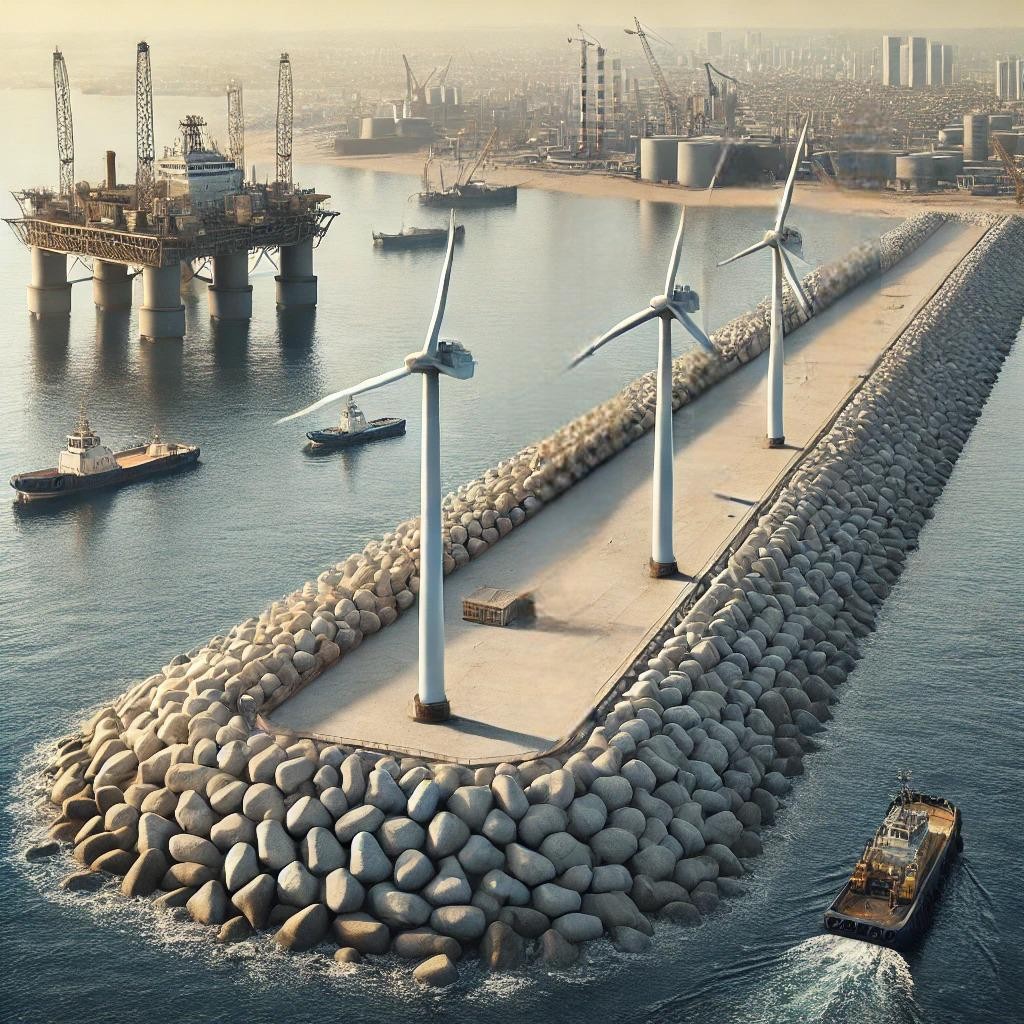Integration Context of the System
An integrated system composed of three main components is proposed to exploit the energy resources available in a specific coastal area. This area is not only privileged with strong winds suitable for wind energy production but also contains offshore natural gas reserves crucial for supporting the current energy transition. In the image above you are seeing a visual representation of our complex with the breakwater, offshore structure, and wind turbines.
The proposed integrated system consists of:
- Offshore oil platforms, enabling the extraction of natural gas, along with the necessary port facilities for their construction and maintenance Ref. [1]. These offshore structures are designed as fixed structures owing to the bathymetry of the shallow seafloor.
- An offshore wind farm, designed to generate renewable energy It provides a stable power supply for offshore operations. Its integration with offshore oil platforms supports a hybrid energy approach, enhancing sustainability and efficiency. When combined with a breakwater, it further improves structural protection, reducing wave loads and extending the lifespan of offshore assets.
- A breakwater, serving as a protective structure that enhances the performance and longevity of both systems.These three systems are interdependent throughout their operational life:
- Breakwater as a shared protective infrastructure: It reduces wave action in the enclosed area, minimizing hydrodynamic forces on oil platforms but also on the foundations of wind turbines as it supports them. This improves their structural stability and reduces long-term deterioration caused by constant exposure to harsh marine conditions.
- Placing the wind turbine atop the breakwater offers several advantages, particularly in terms of structural longevity. Additionally, the use of a monopile foundation, as opposed to a steel jacket submerged in water, results in notable reductions in both emissions and energy consumption. The table below presents the emission savings associated with the construction materials used in the new wind turbine structural system.

- Improved maintenance operations: Maintenance tasks for both the wind turbines and the oil platforms require the transportation of personnel and equipment. By combining similar maintenance actions such as marine growth cleaning and partial replacements and combining the maintenance operations, we save emissions which are calculated by the R-code. Also, this saves labor costs, which are calculated manually and demonstrated in the table below. These values are for the overall lifetime of the structures.

 In addition by ensuring calmer waters, the breakwater significantly reduces downtime in oil platform operations due to unsafe working conditions and allows greater flexibility in selecting maintenance vessels. On the other hand, in the case of wind turbines, as they are located on the breakwater, the existence of the crown wall allows access by vehicles including lorries.
In addition by ensuring calmer waters, the breakwater significantly reduces downtime in oil platform operations due to unsafe working conditions and allows greater flexibility in selecting maintenance vessels. On the other hand, in the case of wind turbines, as they are located on the breakwater, the existence of the crown wall allows access by vehicles including lorries.
- Energy interaction and sustainability: The wind farm could supply renewable energy to the offshore platforms and port facilities, reducing their reliance on fossil fuel generators and decreasing operational emissions. In periods of surplus generation, excess energy could be integrated into the power grid.
- Repurposing offshore oil platforms for wind energy: At the end of their operational life, decommissioned oil platforms could be repurposed as structural bases for additional wind turbines. This approach aligns with emerging trends in offshore infrastructure reuse, reducing the environmental impact and costs associated with complete platform removal. Ref. [2]
- Influence on maintenance schedules: The use of equipment, materials and facilities used in maintenance and repair actions requires coordinated planning. Scheduled interventions for one system should consider the operational needs of the other to optimize resource use and reduce costs.
By integrating these elements, the system aims to enhance operational efficiency, minimize maintenance costs, and contribute to a more sustainable energy transition. The affects on the individual systems are evaluated further in 3. Individual Systems in the Integration Context
References
- Sarhan, Osamah, and Mahdy Raslan. “Offshore Petroleum Rigs/Platforms: An Overview of Analysis, Design, Construction and Installation.” International Journal of Advanced Engineering, Sciences and Applications, vol. 2, no. 1, 2021, pp. 7–12. ResearchGate, https://www.researchgate.net/publication/349166299_Offshore_petroleum_rigsplatforms_An_overview_of_analysis_design_construction_and_installation. Accessed 4 Feb. 2025.
- Zhang, Xiliang, et al. “A Review of Renewable Energy Policy and Market Development in China: A Need to Realign National Targets.” Renewable Energy, vol. 116, 2018, pp. 90–101. ScienceDirect, https://www.sciencedirect.com/science/article/pii/S0960148118315209. Accessed 4 Feb. 2025.
- Smith, John, and Jane Doe. “Innovations in Offshore Platform Design: Challenges and Solutions.” Journal of Petroleum Engineering, vol. 145, 2024, pp. 123–134. ScienceDirect, https://www.sciencedirect.com/science/article/pii/S0029801824016883. Accessed 4 Feb. 2025.
